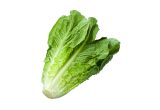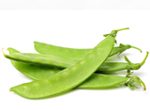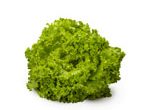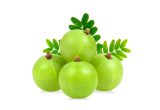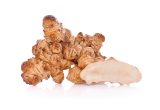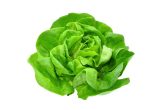Limes

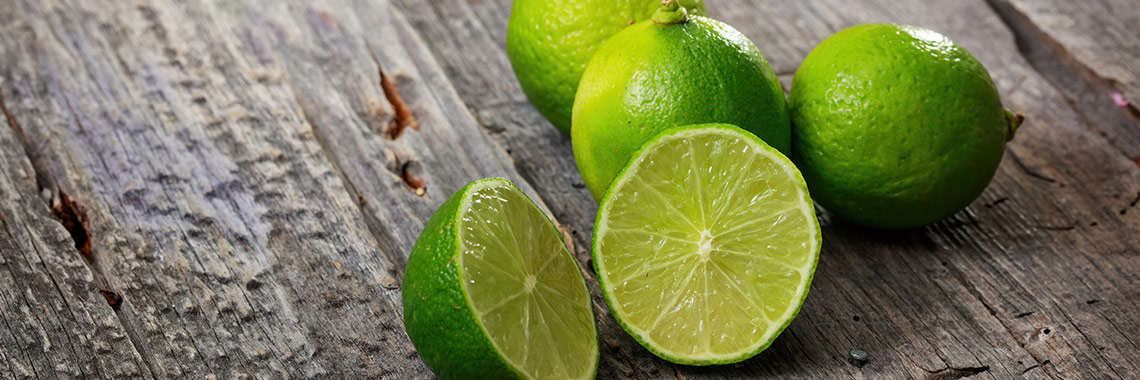
Description
- Limes belong to the Rutaceae family.
- There are 2 main species: Citrus aurantiifolia and Citrus latifolia.
- The Citrus aurantiifolia Swingle cultivar is the most widespread (Bisen, 2012). It occurs in tropical and subtropical regions, India, North America, Egypt and Central America (Sandoval-Montemayor, 2012).
PHYSICAL AND ORGANOLEPTIC CHARACTERISTICS
- Limes are a non-climacteric fruit (meaning they ripen on the tree only). They can be stored for a long time. Bisen, 2012).
- Once ripe, the fruits are light green (Bisen, 2012).
- They are classified into three main groups: sour or bitter, sweet and “tangerine type” (Cano-LamadridM, 2018).
- Among the main volatiles identified in lime juice:
- Bitter lime has the highest ester content,
- Sweet lime has similar quantities of monoterpenes and monoterpenoids.
- Analysis of the peels of these two types of limes revealed significantly higher ester contents than in lemons (Cano-LamadridM, 2018).
COMPOSITION CHARACTERISTICS (excluding macronutrients, vitamins and minerals)
- Limes are reported to have strong antioxidant properties related to their phytochemical composition (Gironés-Vilaplana, 2014):
- An analysis of lime juice revealed the presence of hesperidin and eriocitrin, the two most abundant flavonoids (polyphenols) (Costa, 2014).
- Fifteen coumarins and furocoumarins have also been identified, including bergamotin, 5-geranyloxy-7-methoxycoumarin and oxypeucedanine hydrate (Costa, 2014).
- Lime juice (Citrus aurantiifolia) has been shown to effectively serve as a lipid-lowering agent due to the presence of flavonoids (Idoko, 2019).
- The potential of Citrus aurantiifolia as an anticancer agent is believed to be due to the inhibition of apoptosis-induced proliferation of colon cancer cells by volatile compounds, including d-limonene and d-dihydrocarvone, which are the predominant ones (Idoko, 2019).
- In addition, phytochemicals such as alkaloids, carotenoids, coumarins, flavonoids, phenolic acids and triterpenoids found in citrus fruits have anticancer properties. Aurantiifolia has been studied for its effect against carcinogenesis through mechanisms such as arresting the mobility of cancer cells in the circulatory system, inhibiting metastasis, blocking angiogenesis, and inducing the tumour suppressor gene and apoptosis (Narang, 2016).
RAW
The following values are approximate and depend on variety, season, ripeness, cultivation conditions, etc.
Limes are low in energy* as they provide an average of 40.20 calories (kcal) per 100 g, i.e. 170 kJ. A lime weighs on average 100 g.
COMPOSITION TABLES
For each nutrient, the tables provide information on the content, minimum and maximum values, as well as the percentage of the Dietary Reference Value (DRVs) for 100 g net of lime (pulp, raw).
*Regulation (EC) No 1924/2006 of the European Parliament and of the Council of 20 December 2006 on nutrition and health claims made on foods.
MACRONUTRIENTS
| Constituent (g) | Average content |
Min-Max per 100g |
DRV% |
|---|---|---|---|
| Water | 86,30 | NC - 88,30 | - |
| Fibers | 4,30 | 2,80 - NC | - |
| Carbohydrates | 3,14 | - | 1,21 |
| Sugars | 2,10 | 1,69 - NC | 2,33 |
| Lipids | < 0,30 | 0 - NC | - |
| Saturated fat | < 0,01 | NC - 0,024 | - |
| Protein | 1,13 | 0,63 - NC | 2,26 |
| Constituent (g) | Amount | Min-Max | DRV% |
|---|---|---|---|
| Water | Ciqual 2020 (valeur issue des analyses Ciqual-Aprifel 2018) | - | - |
| Fibers | Ciqual 2020 (valeur issue des analyses Ciqual-Aprifel 2017) | - | - |
| Carbohydrates | Ciqual 2020 | - | Règlement (UE) N°1169/2011 du parlement Européen et du conseil du 25 octobre 2011 |
| Sugars | Ciqual 2020 (valeur issue des analyses Ciqual-Aprifel 2018) | - | Règlement (UE) N°1169/2011 du parlement Européen et du conseil du 25 octobre 2011 |
| Lipids | Ciqual 2020 (valeur issue des analyses Ciqual-Aprifel 2018) | - | Règlement (UE) N°1169/2011 du parlement Européen et du conseil du 25 octobre 2011 |
| Saturated fat | Ciqual 2020 (valeur issue des analyses Ciqual-Aprifel 2018) | - | Règlement (UE) N°1169/2011 du parlement Européen et du conseil du 25 octobre 2011 |
| Protein | Ciqual 2020 (valeur issue des analyses Ciqual-Aprifel 2018) | - | Règlement (UE) N°1169/2011 du parlement Européen et du conseil du 25 octobre 2011 |
Zoom on carbohydrates
- The carbohydrate content of limes (3.14 g per 100 g) is well below the average amount found in fresh fruit (11.31 g per 100 g).
- These are essentially glucose (0.80 g per 100 g), fructose (0.80 g per 100 g) and sucrose (0.50 g per 100 g).
- Limes are low in sugar* as they contain less than 5 g per 100 g.
Zoom on fibres
- Limes are a source of fibre* as they provide more than 3 g per 100 g, i.e. 4.30 g of fibre per 100 g.
- This amount is higher than the average content in fresh fruit (2.77 g per 100 g).
Zoom on proteins
- Limes have a higher protein content (1.13 g per 100 g) than the average quantity found in fresh fruit (0.93 g per 100 g).
Zoom on lipids
- Limes are fat-free* as they contain less than 0.5 g of fat per 100 g.
*Regulation (EC) No 1924/2006 of the European Parliament and of the Council of 20 December 2006 on nutrition and health claims made on foods.
MINERALS AND TRACE ELEMENTS
| Constituent | Average content |
Min-Max per 100g |
DRV% |
|---|---|---|---|
| Calcium (mg) | 57 | 33 - NC | 7,13 |
| Chloride (mg) | < 20 | - | - |
| Copper (mg) | 0,08 | 0,065 - NC | 8 |
| Iron (mg) | 0,20 | NC - 0,60 | 1,43 |
| Iodine (µg) | < 20 | - | - |
| Magnesium (mg) | 14 | 6 - NC | 3,73 |
| Manganese (mg) | 0,09 | 0,008 - NC | 4,50 |
| Phosphorus (mg) | 24 | 18 - NC | 3,43 |
| Potassium (mg) | 190 | 102 - NC | 9,50 |
| Selenium (µg) | < 20 | - | - |
| Sodium (mg) | 6 | 2 - NC | - |
| Zinc (mg) | 0,15 | 0,11 - NC | 1,50 |
| Constituent | Amount | Min-Max | DRV% |
|---|---|---|---|
| Calcium (mg) | Ciqual 2020 (valeur issue des analyses Ciqual-Aprifel 2018) | - | Règlement (UE) N°1169/2011 du parlement Européen et du conseil du 25 octobre 2011 |
| Chloride (mg) | Ciqual 2020 (valeur issue des analyses Ciqual-Aprifel 2018) | - | Règlement (UE) N°1169/2011 du parlement Européen et du conseil du 25 octobre 2011 |
| Copper (mg) | Ciqual 2020 (valeur issue des analyses Ciqual-Aprifel 2018) | - | Règlement (UE) N°1169/2011 du parlement Européen, et du conseil du 25 octobre 2011 |
| Iron (mg) | Ciqual 2020 (valeur issue des analyses Ciqual-Aprifel 2018) | - | Règlement (UE) N°1169/2011 du parlement Européen et du conseil du 25 octobre 2011 |
| Iodine (µg) | Ciqual 2020 (valeur issue des analyses Ciqual-Aprifel 2018) | - | Règlement (UE) N°1169/2011 du parlement Européen et du conseil du 25 octobre 2011 |
| Magnesium (mg) | Ciqual 2020 (valeur issue des analyses Ciqual-Aprifel 2018) | - | Règlement (UE) N°1169/2011 du parlement Européen et du conseil du 25 octobre 2011 |
| Manganese (mg) | Ciqual 2020 (valeur issue des analyses Ciqual-Aprifel 2018) | - | Règlement (UE) N°1169/2011 du parlement Européen et du conseil du 25 octobre 2011 |
| Phosphorus (mg) | Ciqual 2020 (valeur issue des analyses Ciqual-Aprifel 2018) | - | Règlement (UE) N°1169/2011 du parlement Européen et du conseil du 25 octobre 2011 |
| Potassium (mg) | Ciqual 2020 (valeur issue des analyses Ciqual-Aprifel 2018) | - | Règlement (UE) N°1169/2011 du parlement Européen et du conseil du 25 octobre 2011 |
| Selenium (µg) | Ciqual 2020 (valeur issue des analyses Ciqual-Aprifel 2018) | - | Règlement (UE) N°1169/2011 du parlement Européen et du conseil du 25 octobre 2011 |
| Sodium (mg) | Ciqual 2020 (valeur issue des analyses Ciqual-Aprifel 2018) | - | - |
| Zinc (mg) | Ciqual 2020 (valeur issue des analyses Ciqual-Aprifel 2018) | - | Règlement (UE) N°1169/2011 du parlement Européen et du conseil du 25 octobre 2011 |
Zoom on minerals and trace elements
- The two minerals and trace elements best represented in lime are:
- potassium with a content equivalent to 9.50% of DRVs, i.e. 190 mg per 100 g,
- and copper with a content equivalent to 8% of DRVs, i.e. 0.08 mg per 100 g.
- The other minerals and trace elements are present in lime in quantities representing less than 8% of DRVs.
VITAMINS
| Constituent | Average content |
Min-Max per 100g |
DRV% |
|---|---|---|---|
| Provitamin A Beta-carotene (µg) | 12,40 | NC - 30 | - |
| Vitamin A equivalent (µg) | 2,07 | NC - 5 | 0,26 |
| Vitamin B1 (mg) | < 0,015 | NC - 0,03 | - |
| Vitamin B2 (mg) | 0,023 | 0,02 - NC | 1,64 |
| Vitamin B3 (mg) | 0,25 | 0,20 - NC | 1,56 |
| Vitamin B5 (mg) | 0,23 | 0,22 - NC | 3,83 |
| Vitamin B6 (mg) | 0,018 | NC - 0,043 | 1,29 |
| Vitamin B9 (µg) | 36,50 | 8 - NC | 18,25 |
| Vitamin C (mg) | 29,30 | 29,10 - NC | 36,63 |
| Vitamin E (mg) | 0,45 | 0,22 - NC | 3,75 |
| Vitamin K1 (µg) | < 0,80 | 0 - NC | - |
| Constituent | Amount | Min-Max | DRV% |
|---|---|---|---|
| Provitamin A Beta-carotene (µg) | Ciqual 2020 (valeur issue des analyses Ciqual-Aprifel 2018) | - | - |
| Vitamin A equivalent (µg) | Calcul à partir de la valeur Provitamine A Béta-carotène* | - | Règlement (UE) N°1169/2011 du parlement Européen et du conseil du 25 octobre 2011 |
| Vitamin B1 (mg) | Ciqual 2020 (valeur issue des analyses Ciqual-Aprifel 2018) | - | Règlement (UE) N°1169/2011 du parlement Européen et du conseil du 25 octobre 2011 |
| Vitamin B2 (mg) | Ciqual 2020 (valeur issue des analyses Ciqual-Aprifel 2018) | - | Règlement (UE) N°1169/2011 du parlement Européen et du conseil du 25 octobre 2011 |
| Vitamin B3 (mg) | Ciqual 2020 (valeur issue des analyses Ciqual-Aprifel 2018) | - | Règlement (UE) N°1169/2011 du parlement Européen et du conseil du 25 octobre 2011 |
| Vitamin B5 (mg) | Ciqual 2020 (valeur issue des analyses Ciqual-Aprifel 2018) | - | Règlement (UE) N°1169/2011 du parlement Européen et du conseil du 25 octobre 2011 |
| Vitamin B6 (mg) | Ciqual 2020 (valeur issue des analyses Ciqual-Aprifel 2018) | - | Règlement (UE) N°1169/2011 du parlement Européen et du conseil du 25 octobre 2011 |
| Vitamin B9 (µg) | Ciqual 2020 (valeur issue des analyses Ciqual-Aprifel 2018) | - | Règlement (UE) N°1169/2011 du parlement Européen et du conseil du 25 octobre 2011 |
| Vitamin C (mg) | Ciqual 2020 (valeur issue des analyses Ciqual-Aprifel 2018) | - | Règlement (UE) N°1169/2011 du parlement Européen et du conseil du 25 octobre 2011 |
| Vitamin E (mg) | Ciqual 2020 (valeur issue des analyses Ciqual-Aprifel 2018) | - | Règlement (UE) N°1169/2011 du parlement Européen et du conseil du 25 octobre 2011 |
| Vitamin K1 (µg) | Ciqual 2020 (valeur issue des analyses Ciqual-Aprifel 2018) | - | Règlement (UE) N°1169/2011 du parlement Européen et du conseil du 25 octobre 2011 |
Zoom on vitamins
- Limes are high in vitamin C as they provide the equivalent of 36.63% of DRVs, i.e. 29.30 mg per 100 g.
- They are also a source of vitamin B9 as they provide the equivalent of 18.25% of DRVs, i.e. 36.50 µg per 100 g.
- The other vitamins are present in quantities representing less than 4% of DRVs.
*Calculation made: Beta-Carotene / 6 + retinol
POLYPHENOLS
Constituent
(mg)
Average content
Min-Max
per 100mg
Flavonoids
(mg)
46,80
46,80 - 46,80
of which
Flavonols
(mg)
0,40
0,40 - 0,40
of which
Flavanones
(mg)
46,40
46,40 - 46,40
Total polyphenols
46,80
46,80 - 46,80
Constituent
(mg)
Amount
Min-Max
Flavonoids
Phénol Explorer 3.6 Méthode utilisée : Chromatographie après hydrolyse
-
of which
Flavonols
Phénol Explorer 3.6 Méthode utilisée : Chromatographie après hydrolyse
-
of which
Flavanones
Phénol Explorer 3.6 Méthode utilisée : Chromatographie après hydrolyse
-
Total polyphenols
Phénol Explorer 3.6 Méthode utilisée : Chromatographie après hydrolyse
-
Zoom on polyphenols
- Polyphenols are substances with an antioxidant effect.
- Limes contain a significant amount of total polyphenols. They are essentially flavanones, from the flavonoid family.
Nutrition and health claims
According to the definitions of nutrition claims as set out in Regulation (EC) No 1924/2006 on nutrition and health claims, and in view of the composition of limes, the following claims may be used:
NUTRITION CLAIMS OF LIMES
- Low in energy (100 g of lime provide less than 40 kcal)
- Fat-free (100 g of lime contain less than 0.5 g of fat)
- Low in sugar (100 g of lime contain less than 5 g of sugar)
- High in vitamin C (100 g of lime provide the equivalent of more than 30% of DRVs)
- Source of fibre (100 g of lime provide the equivalent of more than 3 g of fibre)
- Source of vitamin B9 (100 g of lime provide the equivalent of more than 15% of DRVs)
HEALTH CLAIMS (for a consumption of 100 g of lime)
Vitamin C
- Vitamin C contributes to:
- normal function of the immune system during and after intense physical exercise,
- normal collagen formation for the normal function of blood vessels,
- normal collagen formation for the normal function of bones,
- normal collagen formation for the normal function of cartilage,
- normal collagen formation for the normal function of gums,
- normal collagen formation for the normal function of skin,
- normal collagen formation for the normal function of teeth,
- normal energy-yielding metabolism,
- normal functioning of the nervous system,
- normal psychological function,
- normal function of the immune system,
- protection of cells from oxidative stress,
- reduction of tiredness and fatigue,
- regeneration of the reduced form of vitamin E.
- Vitamin C increases iron absorption.
Folates or vitamin B9
- Folates contribute to:
- maternal tissue growth during pregnancy,
- normal amino acid synthesis,
- normal blood formation,
- normal homocysteine metabolism,
- normal psychological function,
- normal function of the immune system,
- reduction of tiredness and fatigue.
- Folates have a role in the process of cell division.
References
-
Agence nationale de sécurité sanitaire de l’alimentation, de l’environnement et du travail. Table de composition nutritionnelle des aliments Ciqual 2020. Consultée le 20/08/2020 depuis le site internet Ciqual https://ciqual.anses.fr/
- Bisen A, Pandey SK, Patel N. Effect of skin coatings on prolonging shelf life of kagzi lime fruits (Citrus aurantifolia Swingle). J Food Sci Technol. 2012;49(6):753-9.
- Cano-Lamadrid M,Lipan L, Hernandez F, Martinez JJ, Legua P, Carbonell-Barrachina AA, Melgarejo P. Quality Parameters, Volatile Composition, and Sensory Profiles of Highly Endangered Spanish Citrus Fruits. Journal of Food Quality. 2018;13p.
- Costa R, Russo M, De Grazia S, Grasso E, Dugo P, Mondello L. Thorough investigation of the oxygen heterocyclic fraction of lime (Citrus aurantifolia (Christm.) Swingle) juice. J Sep Sci. 2014;37(7):792-7.
- Gironés-Vilaplana A, Moreno DA, García-Viguera C. Phytochemistry and biological activity of Spanish Citrus fruits. Food Funct. 2014;5(4):764-72.
- Idoko Alexander (2019). Citrus – Health Benefits and Production Technology. Muhammad Sajid and Amanullah, IntechOpen, 582 p.
- Narang N, Jiraungkoorskul W. Anticancer Activity of Key Lime, Citrus aurantifolia. Pharmacogn Rev. 2016;10(20):118-122.
- Neveu V, Perez-Jiménez J, Vos F, Crespy V, du Chaffaut L, Mennen L, Knox C, Eisner R, Cruz J, Wishart D, Scalbert A. (2010) Phenol-Explorer: an online comprehensive database on polyphenol contents in foods. Database, doi: 10.1093/database/bap024. Full text (free access)
- Règlement (CE) N° 1924/2006 du Parlement européen et du Conseil du 20 décembre 2006 concernant les allégations nutritionnelles et de santé portant sur les denrées alimentaires.
- Règlement (UE) N°432/2012 de la Commission du 16 mai 2012 établissant une liste des allégations de santé autorisées portant sur les denrées alimentaires, autres que celles faisant référence à la réduction du risque de maladie ainsi qu’au développement et à la santé infantiles.
- Règlement (UE) n°1169/2011 du Parlement européen et du Conseil du 25 octobre 2011 concernant l’information des consommateurs sur les denrées alimentaires, modifiant les règlements (CE) n°1924/2006 et (CE) n°1925/2006 du Parlement européen et de Conseil et abrogeant la directive 87/250/CEE de la Commission, la directive 90/496/CEE du Conseil, la directive 1999/10/CE de la Commission, la directive 200/13/CE du Parlement européen et du Conseil, les directives 2002/67/CE et 2008/5/CE de la Commission et le règlement (CE) n°608/2004 de la Commission.
- Sandoval-Montemayor NE, García A, Elizondo-Treviño E, Garza-González E, Alvarez L, del Rayo Camacho-Corona M. Chemical composition of hexane extract of Citrus aurantifolia and anti-Mycobacterium tuberculosis activity of some of its constituents. Molecules. 2012;17(9):11173-84.





